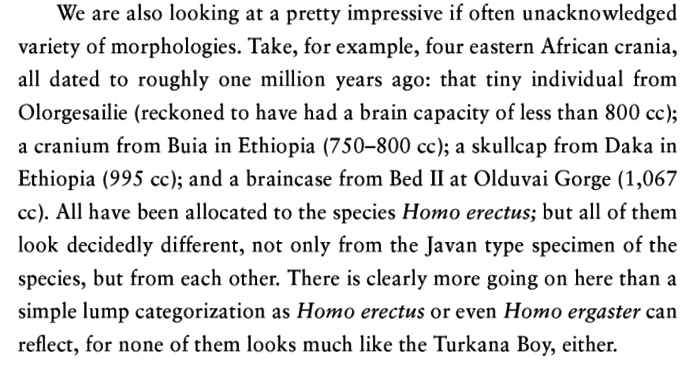Briefly, the authors argue against the commonly received view that the techniques for producing Acheulean handaxes were acquired by social learning and that handaxes are therefore cultural. They argue that language need not have been involved in showing another individual how to make them.
Finally, they write: “A further problem facing the cultural transmission hypothesis is the much more rapid pace of change after Acheulean handaxes disappeared at 300‐200 Ka. If the behaviors involved in the production of both handaxes and post‐Acheulean artifacts were culturally learned, how do we explain this very marked increase in the speed of change?”
Hi Vincent,
I am aware that there are different theories about the Acheulean hand axes, and that they remained essentially unchanged for a very long time. I have considered those things in my evaluation of when humanity might have first appeared, meaning ensouled humanity. I have also considered the rapid burst of culture starting 80K to 70Kya, including jewelry, art, and finally agriculture.
There are three time points to choose for Adam in my opinion: roughly 2 million years ago with Homo erectus, 300 kya with modern man (anatomically speaking), and at the time of our emergence from Africa (70-80 Kya).
The degree of sophistication that goes into making an Acheulean hand axe is greater than it might seem. See this paper. Cognitive Demands of Lower Paleolithic Toolmaking And there is evidence the axes were made in one location then transported long distances, in large numbers. Trade?
Look at this image of a handaxe found at Kathu Pan in South Africa 800 Kya. Michael Cope's Blog: Image
A description of the site and other materials found there are from a mitigation report (!):
This site, situated between the town of Kathu and the SIOC airport, is a shallow water pan about 30ha in
extent. The site was extensively studied from 1974 to 1990 by Humpreys and Beaumont, amongst others.
Kathu Pan, which has been nominated for National Heritage status is an extremely significant site as it
represents the major industries of the Stone Age, more specifically two phases of the Earlier Stone Age,
two phases of the Middle Stone Age, and more or less the entire Later Stone Age (Beaumont 1990). The
site yielded large amounts of hand axes and faunal remains, including the concentrated remains of large
mammal remains. As such, the site has produced fossils of animals such as elephants and hippos, as well
as the earliest known evidence of tools used as spears from a level dated to half a million years
ago. Research by Jayne Wilkins revealed a hoard of stone points, each between 4 and 9 centimeters long, that they think belonged to the earliest stone-tipped spears yet found. The stone points are the right shape and size for the hunting, and some have fractured tips that suggest they were used as weapons. Since stone points used on spears had been found only at sites that date back no more than 300 000 years, these discoveries in the 500 000-year-old deposits at Kathu is greatly significant. In addition, the site has yielded what is termed, the ‘Master Hand-Axe’ which dates to approximately 750 000 BP rendering it the oldest artifact which is indisputably aesthetic i.e. worked for beauty and symmetry, perfectly oriented, and worked considerably beyond the functional requirements of the hand-axe, which could have been achieved with half or fewer blows (see Figure 4-2). The technology which produced it is known as the Acheulian, and the artifacts are thought to be made by Homo ergaster (Homo erectus in Africa), a diverse grouping of early humans commonly imagined as small-brained, small-jawed and robustly built, with heavy eyebrow ridges.

When I look at that master handaxe, I see aesthetics, painstaking care, and a joy in the materials. I see mind.
As for brain sizes, I don’t find that all that significant. Brain size does not necessarily determine intelligence. I have also seen different ranges offered. It is the range of sizes that matters. From Ian Tattersall:

The reason I place Adam so far back? It is the problem of ensoulment, of monogenism, and of genetics. It’s pretty clear that Denisovans and Neanderthals are derived from H erectus after he migrated out of Africa. It solves the problem of an huge initial population size, and gives pop gen time to work. No, I don’t think ILS is a problem. The sorting was pretty much done by then. Last, I have difficulty accepting that God would have parallel races derived from the same ancestry, and ensoul some and not others. That’s if I accept common ancestry. With a unique origin that is early, everyone is ensouled.
Just as an aside, is it our brain size that grants us souls? No. There are many disabled individuals with smaller than average brain sizes, some quite small. Does that mean they have no souls? You are Catholic, I think. I am too. At least for me, it is impossible that those disabled individuals would have no souls. And God chooses to ensoul us irrespective of our physical or mental condition
Issues? There’s that long wait for technology to develop, and the fact that most people will want a more recent Adam. Chris, I personally don’t see a need to match Adam’s time to agriculture, when we have cave paintings twice as old.
That is, unless you are comfortable denying a soul to the ones who painted those pictures.


